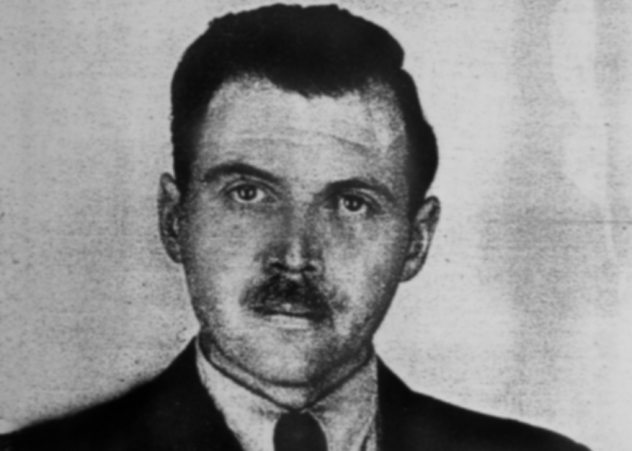 Weird Stuff
Weird Stuff  Weird Stuff
Weird Stuff  Our World
Our World 10 Ways Your Christmas Tree Is More Lit Than You Think
 Movies and TV
Movies and TV The 10 Coolest Stars to Set Sail on The Love Boat
 History
History 10 Things You Didn’t Know About the American National Anthem
 Technology
Technology Top 10 Everyday Tech Buzzwords That Hide a Darker Past
 Humans
Humans 10 Everyday Human Behaviors That Are Actually Survival Instincts
 Animals
Animals 10 Animals That Humiliated and Harmed Historical Leaders
 History
History 10 Most Influential Protests in Modern History
 Creepy
Creepy 10 More Representations of Death from Myth, Legend, and Folktale
 Technology
Technology 10 Scientific Breakthroughs of 2025 That’ll Change Everything
 Weird Stuff
Weird Stuff Ten Bizarre Facts About The Doge Meme
 Our World
Our World 10 Ways Your Christmas Tree Is More Lit Than You Think
 Movies and TV
Movies and TV The 10 Coolest Stars to Set Sail on The Love Boat
Who's Behind Listverse?

Jamie Frater
Head Editor
Jamie founded Listverse due to an insatiable desire to share fascinating, obscure, and bizarre facts. He has been a guest speaker on numerous national radio and television stations and is a five time published author.
More About Us History
History 10 Things You Didn’t Know About the American National Anthem
 Technology
Technology Top 10 Everyday Tech Buzzwords That Hide a Darker Past
 Humans
Humans 10 Everyday Human Behaviors That Are Actually Survival Instincts
 Animals
Animals 10 Animals That Humiliated and Harmed Historical Leaders
 History
History 10 Most Influential Protests in Modern History
 Creepy
Creepy 10 More Representations of Death from Myth, Legend, and Folktale
 Technology
Technology 10 Scientific Breakthroughs of 2025 That’ll Change Everything
10 Strange Claims Debunked By DNA Testing
Ever since its invention, there has been no greater tool for solving mysteries and closing criminal cases than DNA profiling. There was once a time when certain mysteries were considered unsolvable, but DNA testing can even provide a definitive explanation for events which took place centuries ago. On the other side of the coin, DNA profiling can also be an effective tool at debunking myths and legends.
10 The Missing Titanic Survivor

One of the most famous tragedies of all time occurred on April 15, 1912, when the RMS Titanic collided with an iceberg. Approximately 1,500 people lost their lives when the ship sank to the bottom of the North Atlantic Ocean. Two of the presumed victims were a Canadian couple named Hudson and Bess Allison, who boarded the ship with their two young children, two-year-old Loraine and seven-month-old Trevor. Since they were first-class passengers, the Allison family had priority access to the lifeboats. Trevor was safely loaded into a lifeboat, but because of a series of misunderstandings, the boat launched before he was joined by the rest of his family. Hudson, Bess, and Loraine Allison never made it off the ship.
However, a shocking revelation about this story emerged on a radio show in 1940 when a woman named Helen Kramer publicly claimed that she was Lorraine Allison. According to Kramer, her life was saved at the last moment when her father put her in a lifeboat next to a man named Mr. Hyde. Since her parents did not survive, this Mr. Hyde raised her as his child and she had no idea he was not her real father. Even more remarkably, Kramer claimed that Mr. Hyde was actually Titanic shipbuilder Thomas Andrews, who had perished in the sinking.
Naturally, the Allison family did not believe Kramer’s story. Nevertheless, a group of Titanic researchers could not resist the opportunity to find out if her claims were true and formed the “Loraine Allison Identification Project.” In December 2013, long after Kramer’s death in 1992, they decided to perform DNA testing on Kramer’s granddaughter and Bess Allison’s great-niece. The tests showed no match between the families, putting to rest the theory that Helen Kramer was Loraine Allison.
9 The Exhumation Of James Hanratty

DNA testing is the most common method used to exonerate innocent people who were wrongly convicted of a crime they did not commit. However, DNA testing can sometimes confirm that a person accepted as wrongly convicted was guilty all along.
On August 23, 1961, long before DNA testing was invented, a scientist named Michael Gregsten was shot to death inside his car on the A6 road at Deadman’s Hill in Bedfordshire, England. His mistress, Valerie Storie, was also found at the scene. She had been raped and shot five times, amd even though the attack would leave her paralyzed from the waist down, she made a miraculous recovery. The investigation eventually led to a career criminal named James Hanratty, whom Storie positively identified as her attacker.
On the basis of Storie’s testimony, Hanratty was found guilty of rape and murder and sentenced to death. However, there was no other evidence tying Hanratty to the crime and he had an alibi placing him 400 kilometers (250 mi) away when the attack took place. Hanratty never stopped maintaining his innocence until he was hanged on April 4, 1962. Many notable figures, including John Lennon, believed that the whole case was a miscarriage of justice and helped form the A6 Defence Committee in order to clear Hanratty’s name.
Finally, in 2002, Hanratty’s body was exhumed, so that DNA testing could be performed on evidentiary material, including semen samples found in Storie’s underwear and a handkerchief. Hanratty’s DNA turned out a perfect match, providing conclusive evidence that he was guilty all along.
8 The Conviction Of Roger Keith Coleman

If there was an American equivalent of James Hanratty, it would probably be Roger Keith Coleman, who initially seemed like a poster child for the unjust execution of innocent people. On March 10, 1981, 19-year-old Wanda McCoy was murdered inside her home in Grundy, Virginia. She was raped, stabbed to death, and nearly beheaded. The prime suspect was McCoy’s brother-in-law, Roger Keith Coleman, who had a previous conviction for attempted rape. Coleman’s pants had small spots of blood on them, and two male pubic hairs found on McCoy’s body were consistent with Coleman’s. Coleman would eventually be convicted of rape and murder and sentenced to death.
However, the evidence against Coleman was very circumstantial and numerous witnesses placed Coleman at other locations during the time period the crime took place. While on death row, Coleman spent the next several years appealing his sentence, and his case garnered enough publicity that he gained a slew of supporters—including Pope John Paul II—who believed in his innocence and petitioned for clemency.
Nevertheless, Coleman was put to death in the electric chair on May 20, 1992. Before his execution, Coleman stated, “An innocent man is going to be murdered tonight,” and expressed hope that his death would play a role in bringing an end to the death penalty. Coleman’s supporters and anti–death penalty activists never stopped fighting to clear his name. Finally, in 2006, they successfully lobbied for DNA evidence from the crime scene to be tested. To their shock, the DNA test officially confirmed beyond a shadow of a doubt that Roger Keith Coleman was the perpetrator.
7 The Reunion Of The Hagans Family

On June 11, 1968, three-year-old Jonathan Hagans disappeared during a family gathering at Jacksonville Beach in Florida. Police assumed that Jonathan walked into the ocean and drowned, but his family wasn’t sure. Shortly before Jonathan went missing, witnesses had seen him following his father toward a snack bar. His family became convinced that two unidentified men and a woman standing near the establishment had abducted Jonathan.
The case remained cold until 1989 when authorities were contacted by a 24-year-old Buffalo man named David Bonnabel, who had recently seen an age-progressed photo of Jonathan Hagans. Bonnabel told the Haganses that he believed he was their long-lost son.
According to Bonnabel, he had been raised in the swamps of Louisiana by a Romanian woman named Rita. Bonnabel claimed that Rita imprisoned and sexually abused him throughout his childhood before he managed to run away during his teen years. He had no idea he had been abducted from his real family until he heard Jonathan’s story. The Hagans family believed Bonnabel’s story at first, but suffered a major heartbreak when DNA testing was performed on him. It confirmed with 100 percent certainty that David Bonnabel was not Jonathan Hagans.
In fact, Bonnabel was nothing more than a ruthless con man. Bonnabel had spent the previous few years peddling a fabricated story to various TV shows about being an abducted child searching for his parents. It turned out Bonnabel was actually a Mexican citizen living illegally in the United States and was hoping to be adopted by an American family to gain US citizenship. Sadly, no trace of the real Jonathan Hagans has ever been found.
6 The Adoption Of Heather Robinson

For years, a Chicago couple named Don and Helen Robinson had trouble conceiving a child or adopting one through traditional channels. However, in January 1985, they were contacted by Don’s brother, John Edward Robinson, and were stunned to learn that he had an infant girl with him. According to John, the child’s mother had recently committed suicide in a domestic violence shelter. If Don and Helen would pay John a couple thousand dollars for legal fees, he could act as a liaison and arrange for them to legally adopt the child. The Robinsons agreed to the arrangement and John soon presented them with adoption papers to sign. The child now officially belonged to Don and Helen, who would raise her under the name Heather Robinson.
Sadly, the couple did not know that John Edward Robinson made no legal arrangements for them at all and had forged the adoption papers. Even worse, he was a serial killer and had likely murdered the child’s real mother. Robinson had a history of criminal behavior, including embezzlement and sexual assault, but things took a much darker turn when the bodies of five women were found inside barrels on both his property and a nearby storage locker. Robinson was given the death penalty for three counts of murder, but he is believed to be responsible for many more deaths.
In January 1985, a woman named Lisa Stasi mysteriously disappeared alongside her four-month-old daughter, Tiffany. At the time, she had recently become acquainted with Robinson. In 2000, DNA testing would confirm that the girl raised as Heather Robinson was Tiffany Stasi. Even though Lisa Stasi is presumed dead, her body has never been found.
5 The Fate Of Dr. Josef Mengele

After the end of World War II, Dr. Josef Mengele was one of the most wanted Nazi war criminals in the world. Known as the “Angel of Death,” Mengele was the notorious physician at Auschwitz concentration camp who performed horrific experiments on Jewish prisoners for the purposes of genetic research. After Auschwitz was liberated, Mengele was held in custody at two American prisoner-of-war camps, but they inexplicably released him. Mengele eventually managed to flee to South America, where he would spend the next three decades on the run. By the ’80s, rumors began circulating that Mengele was dead, but there were still unconfirmed sightings of him throughout the world, and $3.5 million in reward money was offered for his capture.
In February 1985, a mock trial was held for Mengele in Jerusalem where 106 of his survivors testified about his atrocities. Two months later, West German police would raid the home of one of Mengele’s friends and find a letter from a couple named Wolfram and Liselotte Bossert which mentioned the death of a mutual friend. The Bosserts were soon located in Brazil and interrogated. They finally led authorities to a cemetery in Embu containing the grave of a man named Wolfgang Gerhard.
According to the Bosserts, Gerhard was actually Josef Mengele. He had drowned after suffering a stroke while swimming on February 7, 1979. Even so, there was still some skepticism that the remains belonged to Mengele. In 1992, the long manhunt was finally brought to a definitive end when DNA testing was performed on Gerhard’s remains, confirming that the dead man was Josef Mengele.
4 The Body Of Martin Bormann

Josef Mengele was not the only notorious Nazi war criminal who required DNA testing to confirm his death. Throughout World War II, Martin Bormann was one of the most powerful members of the Nazi party, serving as Adolf Hitler’s private secretary. On May 2, 1945, two days after Hitler committed suicide, Bormann was seen leaving Berlin to deliver orders to Hitler’s potential successor. This was the last time anyone could confirm seeing Bormann alive and his fate would remain a mystery for decades.
After the war ended, Bormann was tried in absentia for war crimes at Nuremberg and sentenced to death. However, even though there were thousands of unconfirmed sightings of Bormann throughout the world, no one could be certain if he was still alive.
During the 1960s, a former Berlin postal worker named Albert Krumnow told authorities that days after Bormann’s disappearance, he had buried two bodies which were found near the Reichstag station. Krumnow believed that one of the bodies might have been Bormann’s. The initial attempts to recover these bodies were unsuccessful, but in 1972, construction workers would uncover the remains of two people in close proximity to where Krumnow claimed he buried them. It was determined that the two victims had committed suicide by taking cyanide. One of them was believed to be Bormann and the second an SS doctor named Ludwig Stumpfegger.
Some people were skeptical that the remains belonged to Bormann. Conspiracy theorists even suggested they had been planted there and that the real Bormann was still alive somewhere. The mystery was finally put to rest in 1998 when DNA testing was performed on skull fragments from the remains, confirming that they did belong to Martin Bormann.
3 The Fake Teenager

In 1997, Brianna Stewart, a 16-year-old high school student from Vancouver, Washington, accused 47-year-old security guard Charles Blankenship of raping her. Blankenship would be charged with having sex with a minor and sentenced to one year in jail.
This seemed to be the latest in a long line of sexual assaults suffered by the enigmatic Brianna Stewart. She spent her teen years living in foster homes, garnering a lot of sympathy with her tales of past abuse. Brianna claimed she ran away from home at age 12 to escape an abusive Satanist father who had murdered her mother. In 2001, Brianna was hoping to attend college, but would need to obtain a birth certificate and Social Security number. During a fingerprint check, a surprising discovery was made: This high schooler was actually a 31-year-old woman named Treva Throneberry.
Treva Throneberry was born in Wichita Falls, Texas in 1969. Even though she was sexually abused by an uncle during her childhood, her tendency to fabricate stories started at age 16 when she falsely accused her father of raping her at gunpoint. After she reached adulthood, Treva spent most of the 1990s traveling the country and passing herself off as a teenager under different aliases. She usually lived in homeless shelters and foster homes and chronicled many outrageous stories of abuse, which often involved Satanism.
After the fingerprint check uncovered Treva’s real identity, she was arrested and charged with theft, fraud, and perjury. Even though she continued to maintain that her real name was Brianna Stewart, DNA testing conclusively determined that she was Treva Throneberry. The false conviction of Charles Blankenship was promptly expunged from his record and Treva was sentenced to three years in prison.
2 The Identification Of Scott Morris

The invention of DNA profiling has often been a godsend for resolving missing persons cases. Sometimes, a dead body will be found and remain unidentified for years until DNA testing matches the deceased victim to a missing person. Even though DNA profiling can provide closure for a victim’s family, there are also rare occasions when it takes closure away.
On August 14, 1978, 14-year-old Scott Morris mysteriously disappeared after leaving his Indianapolis home to walk to a nearby market. At the time, Scott was known for being a runaway, so police did not take his disappearance seriously. Scott’s family never saw him again, but a family friend received a strange call in 1989 from a man claiming to be Scott, who confirmed he was still alive and working at a carnival.
Years later, Scott’s family received surprising news about a seemingly unrelated cold case. On January 7, 1990, a nude unidentified young man was found beaten and shot to death in Daviess County, Kentucky. Since the victim’s hands and feet had been cut off and all his teeth were removed, identification was difficult. However, in 2007, a search of the missing persons database led authorities to Scott Morris, who bore a striking resemblance to the victim. The body was tentatively identified as Scott. He was returned to the Morris family and given a proper burial.
Unfortunately, it turned out the identification had been premature. In 2009, the final portions of the DNA identification process were completed and authorities were horrified to learn they had made a mistake: The unidentified victim was not Scott Morris. Sadly, two separate cold cases have now reverted back to their unsolved status.
1 The Heart Of Dauphin Louis XVII Of France

Few historical figures spawned more questions about their presumed death than Louis XVII, who was the son of King Louis XVI of France and Queen Marie Antoinette. In August 1792, in the midst of the French Revolution, Louis XVI was arrested and removed from power. While both of his parents were executed, Louis XVII would be imprisoned in the tower of Paris Temple for the next three years. During that time, he became seriously ill and died of tuberculosis on June 8, 1795 at the age of 10. After this death, an autopsy was performed on the boy and his heart was removed. However, rumors eventually began circulating that Louis-Charles did not actually die and had escaped after his sympathizers smuggled him out of the prison.
Due to the long-standing rumors that the dauphin survived, hundreds of impostors came forward over the years to claim they were him. As the years went on, fraudulent impostors even started claiming they were descendants of Louis XVII, but none of their stories could be verified. After Louis-Charles’ heart was removed, it was preserved and housed in many places over the next two centuries. Finally, in 1975, the heart found a permanent home on display inside a crystal vase at the royal crypt in the Saint Denis Basilica, the burial place of King Louis XVI and Marie Antoinette. In 2000, DNA testing was finally performed on the heart and compared with DNA samples from a strand of Marie Antoinette’s hair. The testing firmly concluded that the heart belonged to the dauphin. It was finally given a proper burial at the royal crypt.
Robin Warder is a budding Canadian screenwriter who has used his encyclopedic movie knowledge to publish numerous articles at Cracked.com. He is also the co-owner of a pop culture website called The Back Row and recently worked on a sci-fi short film called Jet Ranger of Another Tomorrow. Feel free to contact him here.








